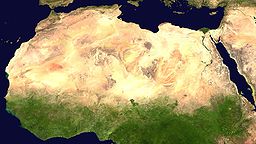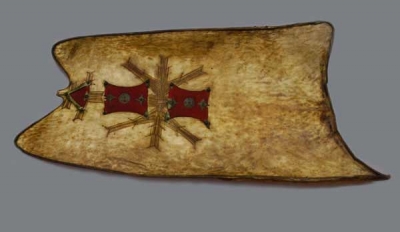Tuareg shield (1913.31.40)
 A satellite image of the Sahara by NASA World WindTuareg shield from the Sahara Desert, Africa. Collected by Olive Susan Miranda Temple (n�e Olive Macleod) between 1910 and 1911. Given to the Museum in 1913.
A satellite image of the Sahara by NASA World WindTuareg shield from the Sahara Desert, Africa. Collected by Olive Susan Miranda Temple (n�e Olive Macleod) between 1910 and 1911. Given to the Museum in 1913.
This large shield was made by the Asben people, a sub-group of the nomadic Tuareg. Although it was collected in Kano in Nigeria, the fact that it is made from dried oryx hide suggests otherwise. Oryx are a type of antelope that prefer near desert conditions so they would be more likely to be found further north towards the Sahara and the border with Niger. As well as providing a thick and hard defensive surface once dried in the sun, oryx hide was also a symbol of military victory throughout the southern Sahara.
Tuareg shields are too large to wield deftly on the arm in combat and were held relatively rigidly by a strap two-thirds of the way up the shield. Camel saddles were carved with a special hook to suspend the shield when not in use. The incised, snowflake-like decoration on the front also appears in rock art found in the western Sahara but there is uncertainty about its meaning. Some think it is a heraldic or armorial device, indicating clan affiliations. Others argue it is an amulet intended to fend off Tehot - the Evil Eye. The most convincing explanation is that it represents Izez, "The Vulture God Who Slaughters the Foe", who is a Tuareg war deity, closely linked to the Arabic and Persian vulture war-god Aziz. As such, it is likely to possess powers of divine invocation.





